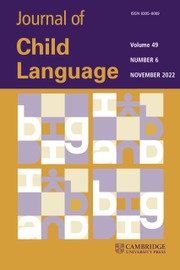Article contents
The acquisition of noun inflection in Northern Pame (Xi'iuy): Comparing whole word and minimal word accounts
Published online by Cambridge University Press: 13 October 2020
Abstract
The study used naturalistic data on the production of nominal prefixes in the Otopamean language Northern Pame (autonym: Xi'iuy) to test Whole Word (constructivist) and Minimal Word (prosodic) theories for the acquisition of inflection. Whole Word theories assume that children store words in their entirety; Minimal Word theories assume that children produce words as binary feet. Northern Pame uses obligatory portmanteaux prefixes to inflect nouns for class, number, animacy and possessor. Singular nouns constitute 90 percent of the nouns that the children hear and yet all five two-year-old children frequently omitted the singular noun prefixes, but produced the low frequency noun suffixes for dual and animate plural. Neither the children's production of the noun-class prefixes nor their prefix overextensions correlated with the adult type and token frequencies of production. Northern Pame children constructed Minimal Words that contain binary feet and disfavor the production of initial, extrametrical prefixes.
Information
- Type
- Article
- Information
- Copyright
- Copyright © The Author(s), 2020. Published by Cambridge University Press
References
- 1
- Cited by


